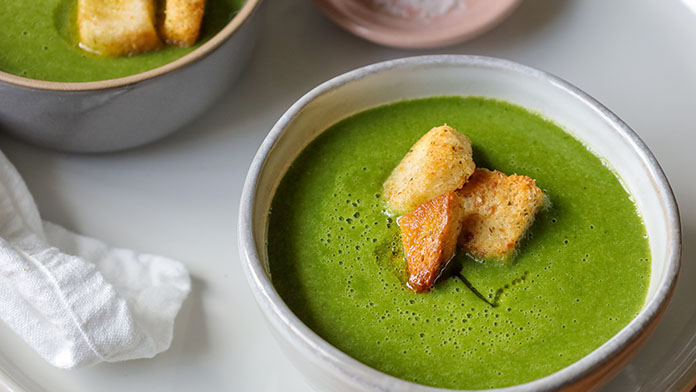The information you will be accessing is provided by another organization or vendor. If you do not intend to leave our site, close this message.
D-SNP home page > Health tips & tools > 15 budget-friendly pantry items that make healthy eating easier
15 budget-friendly pantry items that make healthy eating easier
Keep these affordable kitchen staples on hand for fast and healthy homemade meals.
 By Kate Rockwood
By Kate Rockwood


Eating healthy isn’t always easy. Some nights, just getting dinner on the table can feel impossible. But here’s a trick that can save you time, stress and money: Stock your kitchen with the right go-to ingredients that have long shelf lives. This gives you the ability to pull together quick, filling and nutritious meals in a pinch.
Here are 15 foods that doctors and dietitians recommend you keep in the cupboard (and freezer). They can enable you to enjoy easy, healthy meals — even on hard days.
1. Canned beans
Red, black, kidney, pinto — canned beans (part of the legume family) are a common pantry staple. So you might not even realize what a nutritional powerhouse they are. Like meat, they’re loaded with protein, iron and zinc, says Michael Greger, MD, founder of NutritionFacts.org. “But legumes also contain nutrients that are concentrated in the vegetable kingdom, including fiber, folate and potassium. So you get the best of both worlds.”
Some easy ideas for enjoying canned beans:
- Mash them, add your favorite seasonings and spread over toast.
- Roll them into a tortilla with canned chopped tomatoes and salsa for burritos.
- Pile pinto or black beans on top of a baked potato. Add shredded cheese, canned corn and salsa for a Southwestern-style loaded potato.
2. Lentils
Lentils have all the benefits of beans and are super easy to use in many ways. “Lentils are tiny, cook quickly and don’t need any soaking time,” says Lynn Beattie, MPH. She’s a nutrition education specialist at the University of Massachusetts Amherst Center for Agriculture, Food, and the Environment.
Beattie recommends giving dried lentils a quick rinse with cool water and cooking them in boiling water. (They take about 20 minutes). Use cooked lentils in soups and stews, add them to a burrito or heap them on top of rice. They can take on many flavors depending on your choice of seasonings.
3. Peanut butter
There’s nothing wrong with a classic PB&J. In fact, peanut butter on whole-wheat bread is a perfect combination, says Taylor C. Wallace, PhD. Wallace, who is based in Washington, D.C., is the CEO at Think Healthy Group and an adjunct professor at George Mason University.
“Peanut butter and whole wheat contain complementary proteins," says Dr. Wallace. “Put together, they give you all the essential amino acids you need.” Peanut butter is high in calories, though, so stick to 1 to 2 tablespoons a day.
4. Brown rice
When shopping for rice, try to get brown instead of white, Dr. Wallace says. That’s especially true if you’re working to maintain a healthy weight or have diabetes. “White bread and white rice are converted to sugar in the body very quickly and are absorbed quickly,” he says. That can raise blood sugar levels.
Brown rice, on the other hand, is a whole grain that’s a good source of fiber. It also breaks down more slowly in the body. One recent review of studies found that eating more whole grains lowers the risk of death from stroke and heart attack.1
5. Whole-wheat pasta
Like brown rice, whole-wheat pasta is a whole grain. The fiber it packs is good for controlling weight and blood sugar, and for fending off chronic conditions such as type 2 diabetes.2,3 To get the maximum nutrition bang for your buck, look for 100 percent whole grain on the label, Dr. Wallace says.
6. Pasta sauce
For quick and easy weeknight dinners, top your whole-wheat pasta with a jar of pasta sauce. Choose a tomato-based sauce such as marinara instead of creamy or cheesy sauces. Tomato sauce is lower in calories and saturated fat. Plus, it’s high in plant nutrients such as heart-healthy lycopene.4
7. Canned tomatoes
You could make your own pasta sauce with canned tomatoes. They make for a more rich flavor than fresh tomatoes. You can also mix them in with chili, curries, soups or gumbos.
8. Canned fish
Fish is an important source of omega-3 fatty acids. These fats are key to keeping your heart and arteries healthy. And in good news, the benefits of fish are the same whether you buy it fresh or stock up on more budget-friendly cans.
Try making salmon burgers with canned salmon. Mix up a classic tuna fish salad. Sardines are another great canned option: They have some of the highest amounts of omega-3s of any fish. In general, pick low-sodium fish canned in water (not oil) to cut down on calories.
9. Canned chicken
It’s another quick meal hack. Canned chicken has all the benefits of fresh chicken — it’s a low-fat protein. But it's cheaper, already cooked and lasts for months in your cupboard. Try it in chicken salad, tacos, quesadillas or casseroles. And be sure to look for a reduced sodium option.
10. Stock
“Stock or broth is a great way to add flavor to soups, stews and grain dishes, without adding a lot of extra calories,” says Carrie M. Durward, PhD, RD. Durward is a nutrition specialist and an associate professor at Utah State University in Logan. “I recommend getting low-sodium options. A lot of brands contain much more sodium than is good for our health and more than you need to make your dish taste good.”
11. Tortillas
Keep small tortillas around for Taco Tuesdays. Or choose larger ones for veggie burritos, quesadillas or making wraps instead of standard sandwiches. “Corn tortillas or 100 percent whole-wheat tortillas are considered whole grains and provide dietary fiber to your meals,” says Beattie.
12. Frozen vegetables
Okay, technically these go in the freezer, not the pantry, but they’re still a long-lasting staple. Frozen veggies are picked at peak ripeness and frozen right away. That means they have all the nutrition of fresh, but they can last for months.
13. Dried herbs and spices
A spice rack full of jars is a great way to keep things interesting when you’re cooking at home. You can transform the same ingredients in a hundred ways by using different combinations of seasonings. There’s a health benefit too: Using spices lets you amp up the flavor of food without adding extra salt or fat from butter.
14. Bulk nuts and seeds
These tiny, tasty foods that have been shown to help you live longer.5 “Nuts and seeds contain protein and minerals, which are needed to maintain healthy bones and muscles,” says Nyssa Entrekin, RD. Entrekin is an associate director of The Food Trust, based in Philadelphia.
Buying nuts and seeds in bulk can make them more affordable. Choose unsalted when possible. Both are great snacks on their own — stick to about a quarter-cup per day (they are high in fat). Or use them to dress up salads, soups, baked goods and oatmeal.
15. Oatmeal
And speaking of oatmeal, don’t forget this great whole grain. It provides vitamins, minerals and fiber, which Entrekin says helps:
- Lower the risk of heart disease
- Make you feel fuller longer
- Maintain blood glucose levels
- Keep digestion regular
And oatmeal isn’t just a breakfast food, says Sandy Procter, PhD. She’s a registered dietitian and an assistant professor and extension specialist in nutrition at Kansas State University. Uncooked oats are a popular add-in for baked goods. And they make a great binding agent in meatballs or meatloaves.
1Reynolds A, Mann J, Cummings J, et al. Carbohydrate quality and human health: a series of systematic reviews and meta analyses. The Lancet. February 2, 2019; 393(10170): 434-445. Accessed on June 13, 2022.
2Mayo Clinic. Dietary fiber: essential for a healthy diet. January 6, 2021. Accessed June 13, 2022.
3Harvard T. H. Chan School of Public Health. Carbohydrates and blood sugar. Accessed June 13, 2022.
4Harvard Health Publishing. Lycopene-rich tomatoes linked to lower stroke risk. October 10, 2012. Accessed June 13, 2022.
5Afshin A, Sur PJ, Fay KA, et al. Health effects of dietary risks in 195 countries, 1990-2017: a systematic analysis for the Global Burden of Disease Study 2017. The Lancet. May 11, 2019; 393(10184): 1958-1972. Accessed June 13, 2022.
Disclaimers
This material is for informational purposes only and is not medical advice. Health information programs provide general health information and are not a substitute for diagnosis or treatment by a physician or other health care professional. Contact a health care professional with any questions or concerns about specific health care needs. Providers are independent contractors and are not agents of Aetna. Provider participation may change without notice. Aetna is not a provider of health care services and, therefore, cannot guarantee any results or outcomes. The availability of any particular provider cannot be guaranteed and is subject to change. Information is believed to be accurate as of the production date; however, it is subject to change. For more information about Aetna plans, refer to our website.



